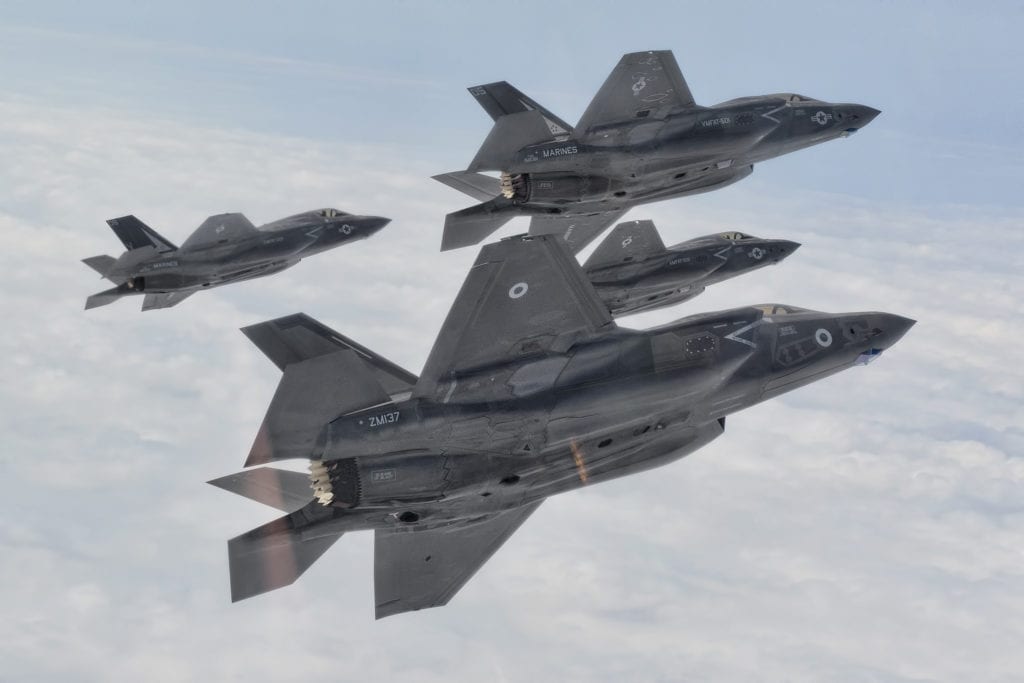Global Avionics Round-Up from Aircraft Value News (AVN)

Four U.S. Marine Corps F-35Bs from Marine Fighter Attack Training Squadron 501. (Lockheed Martin)
Geopolitical tensions have long been a factor behind aviation and avionics development. However, in today’s highly volatile global landscape, these pressures are reshaping avionics in ways that extend beyond military applications.
From Eastern Europe to the Middle East, strife among countries is spilling into commercial aviation supply chains and technological partnerships. The escalating trade war is only making tensions worse. Avionics manufacturers and airline operators are being forced to adapt to a rapidly evolving environment.
Military conflicts and rising defense budgets are fueling new advancements in avionics. Nations across the globe are investing heavily in radar, surveillance, and electronic warfare capabilities.
The demand for more robust cybersecurity measures, artificial intelligence (AI)-enhanced avionics, and advanced electronic countermeasures has accelerated avionics research and development (R&D).
The U.S., China, Russia, and the European Union are prioritizing avionics that enhance combat readiness and network-centric warfare, which in turn influences commercial applications.
Historically, military advancements have been a key driver of broader technological breakthroughs, with innovations in radar, communication, and automation frequently finding their way into commercial and civilian aviation.
Commercial and military aviation are deeply interconnected through the development and application of “dual-use” avionics technologies, which are systems originally designed for defense that later find widespread civilian use, and vice versa.
Innovations such as GPS navigation, fly-by-wire control systems, synthetic vision, and advanced collision-avoidance technologies were first honed in military settings before being adapted for commercial aircraft to enhance safety, efficiency, and situational awareness.
Conversely, the commercial sector often contributes cutting-edge advancements in cockpit automation, human-machine interface design, and data connectivity that are increasingly adopted by defense programs aiming to modernize fleets and reduce pilot workload. This continual cross-pollination not only accelerates technological progress but also underscores how avionics serve as a vital bridge between military imperatives and civilian innovation.
However, the current geopolitical landscape is introducing new complexities that could hinder efficiency and cost control across the aviation industry. The tit-for-tat tariff battle between China and the U.S. has substantially raised the stakes.
Supply Chain Disruptions and Localization
Geopolitical strife is disrupting global supply chains, particularly in the semiconductor and avionics sectors. Sanctions, trade restrictions, and export controls have driven a shift toward localization.
The U.S.-China trade war and embargoes on Russian technology have pushed aviation firms to seek alternative suppliers and invest in domestic manufacturing. Avionics industry leaders say that this shift is leading to increased production costs and longer development cycles, forcing avionics companies to rethink procurement strategies and strategic partnerships.
As security concerns grow, regulatory bodies are placing stringent requirements on avionics systems, particularly those used in international operations. Countries are becoming increasingly protective of their airspace and aviation infrastructure, which is leading to avionics standards that are focused on domestic markets rather than international ones. While this fragmentation enhances a country’s national security, it complicates avionics interoperability and raises costs for aircraft manufacturers and airlines.
The fragmentation of the global aviation market is particularly concerning. Sanctions, trade restrictions, and shifting alliances are limiting collaboration among key aerospace players, disrupting supply chains, and making it more difficult for manufacturers to source critical components.
The “de-coupling” of the U.S. and Europe under the Trump administration is causing anxiety in the C-suites of Western aviation companies. This uncertainty is exacerbated by the likelihood of higher inflation and a global economic recession due to the trade war unleashed by the White House.
The push for domestic production and self-sufficiency in avionics development, while beneficial for national security, often results in redundancies and increased costs. Diverging regulatory standards among geopolitical blocs are creating further inefficiencies, forcing manufacturers to develop multiple versions of the same technology to meet regional requirements.
However, despite these challenges, geopolitical tensions also are fueling greater investment in next-generation avionics, including AI-driven automation, cybersecurity measures, and electronic warfare capabilities. These crosscurrents are likely to persist throughout 2025 and beyond.
This article also appeared in our partner publication, Aircraft Value News.
John Persinos is the editor-in-chief of Aircraft Value News. You can reach John at: [email protected].